
The Himalayas of India: Ladakh and Dharamsala,
Summer 2008
Ladakh:
Thikse and Hemis Monasteries, Shanti Stupa
Page 2 of 16
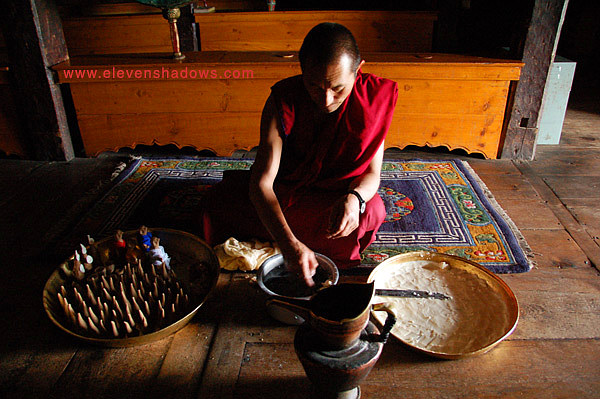 Inside
Thikse Monastery, a monk prepares butter sculptures... Inside
Thikse Monastery, a monk prepares butter sculptures... |
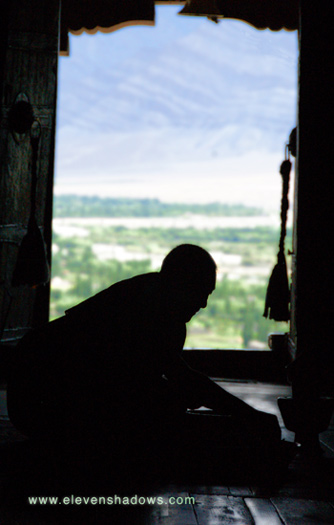 ...with
the glow of the vast Indus Valley as the lamp for his work. ...with
the glow of the vast Indus Valley as the lamp for his work. |
 The
spectacular Thikse Monastery, growing out of the rocky mountain rising above the
Indus Valley. The
spectacular Thikse Monastery, growing out of the rocky mountain rising above the
Indus Valley.We ate at a restaurant run by the Thikse Monastery, eating thantuk, a Tibetan soup with flat square noodles and vegetables, washed it down with delicious Kashmiri apple juice, and then continued down the road, following the Indus River to Hemis Monastery. ~~ When I came back from Ladakh eleven years ago, I took my film to a lab. When I went to get my prints back, the guy asked, "How did you get the sky so blue? What kind of filters did you use?" I replied that I didn't use any filters, and that the sky was really that blue due to the elevation. If you love gorgeous blue skies, it doesn't get much better than the Himalayas. |
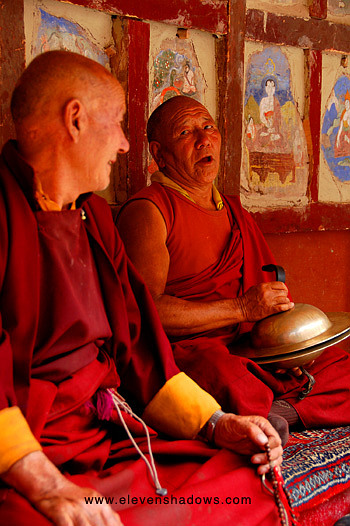 After
crossing the Indus River, we drove along a winding road, climbing up further
towards a valley. Hemis Monastery clung to the sides of a towering
mountain, with jagged peaks looming overhead like something out of "Lord of
the Rings". We arrived to see monks practicing for the Hemis Festival next
month, performing largely one-legged dances, playing hide-and-go-seek,
drinking chai, painting, and laughing. Although more than two weeks
away, they were practicing for the Hemis Festival, which I was eager to
attend. After
crossing the Indus River, we drove along a winding road, climbing up further
towards a valley. Hemis Monastery clung to the sides of a towering
mountain, with jagged peaks looming overhead like something out of "Lord of
the Rings". We arrived to see monks practicing for the Hemis Festival next
month, performing largely one-legged dances, playing hide-and-go-seek,
drinking chai, painting, and laughing. Although more than two weeks
away, they were practicing for the Hemis Festival, which I was eager to
attend. |
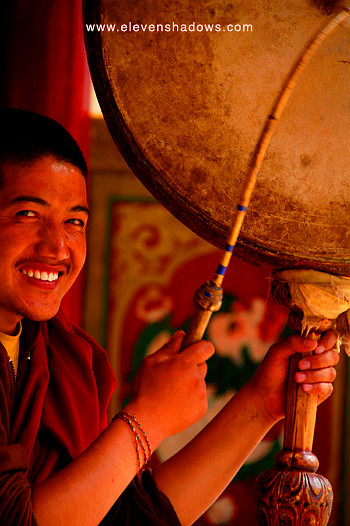 A
young monk beams as he sounds the drum during rehearsal for the upcoming
Hemis Festival. A
young monk beams as he sounds the drum during rehearsal for the upcoming
Hemis Festival. |
 Monks
rehearsing slow dances for the Hemis Festival. When fully attired in
frightening skeleton masks, the slow drums and largely one-legged dances are
hypnotic; when in rehearsal, they have more an air of absurdity. Monks
rehearsing slow dances for the Hemis Festival. When fully attired in
frightening skeleton masks, the slow drums and largely one-legged dances are
hypnotic; when in rehearsal, they have more an air of absurdity. |
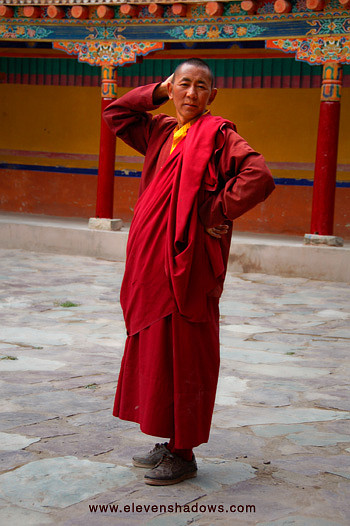 Tenzin from Hemis displays the upcoming 2008 Fall Ladakhi robe, perfect
for that monk on the go, wouldn't you agree? Tenzin from Hemis displays the upcoming 2008 Fall Ladakhi robe, perfect
for that monk on the go, wouldn't you agree? |
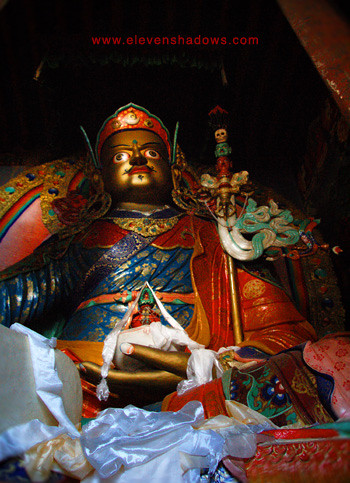 The
Hemis Monastery has a temple devoted to Guru Rinpoche, or Padmasambhava, who
brought Buddhism to Tibet. The
Hemis Monastery has a temple devoted to Guru Rinpoche, or Padmasambhava, who
brought Buddhism to Tibet.
Hemis Monastery has a particular significance, too, for those who believe that Jesus may have come to India and the Himalayas. A Russian writer/explorer named Nicholas Notovich allegedly visited Hemis Monastery, where a monk showed him and gave him a remarkable translation of a manuscript stating that Jesus, or Saint Issa, had visited India. This manuscript has since disappeared, although Professor Hassnain and other Jesus-in-India scholars have a diary from a Christian monk at the Moravian Church in Leh that states that Notovitch did indeed visit Hemis Monastery. This manuscript is one of numerous manuscripts that allegedly state that Jesus visited India. Although reading that it had disappeared, I inquired about the manuscript anyway. One of the head lamas in the Hemis Museum stated that Jesus may or may not have gone to Tibet, but in either case, he did not know of any manuscripts of Jesus or Issa ("not here"). I asked whether it could be in the Tibetan Library in Dharamsala. "Maybe, but not here." I was heading for Dharamsala in just three weeks. What would I find in the Tibetan Library? I have no idea whether Jesus visited India during his "Lost Years" between 13-30. But like anybody else, I love a great mystery, and was only too happy to explore it while here in the Himalayas, a land where just about anything seemed possible. |
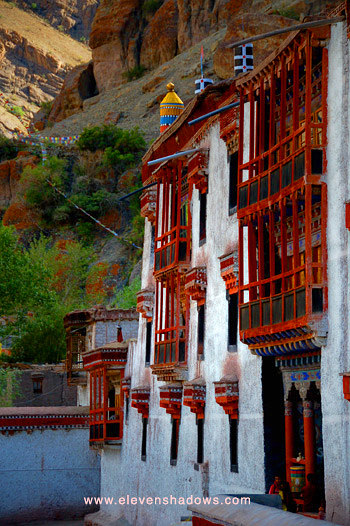 The
Hemis Monastery, nestled in a spectacular valley with jagged peaks
above and surrounded by streams, belongs to the Drukpa order and was founded
in the early 17th Century. The
Hemis Monastery, nestled in a spectacular valley with jagged peaks
above and surrounded by streams, belongs to the Drukpa order and was founded
in the early 17th Century. |
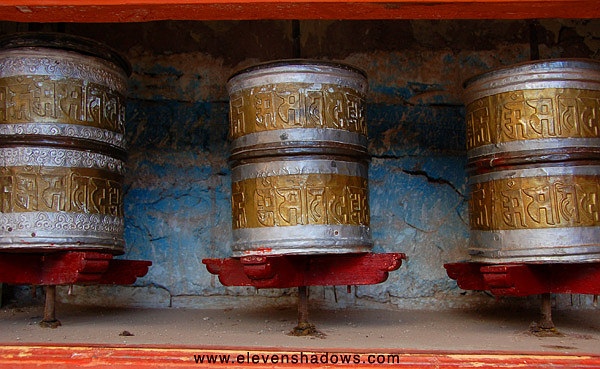 Prayer
wheels near the Padmasambhava Temple in the Hemis Monastery courtyard.
Every year, the monastery holds their famous annual festival to commemorate
the birth of Indian guru Padmasambhava, held on the 9th to 11th days of the
5th Tibetan month (lunar calendar), which falls in late June to mid-July.
I was eager to return to Hemis to see the festival. Prayer
wheels near the Padmasambhava Temple in the Hemis Monastery courtyard.
Every year, the monastery holds their famous annual festival to commemorate
the birth of Indian guru Padmasambhava, held on the 9th to 11th days of the
5th Tibetan month (lunar calendar), which falls in late June to mid-July.
I was eager to return to Hemis to see the festival. |
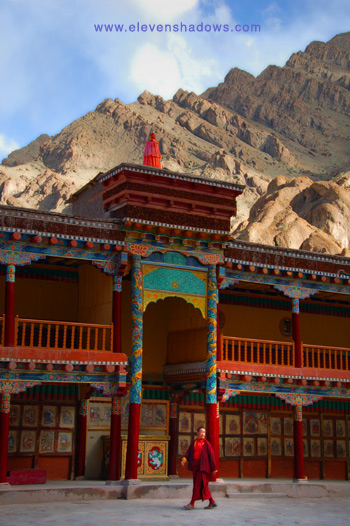 Another
view of the Hemis Monastery from the courtyard. Another
view of the Hemis Monastery from the courtyard. |
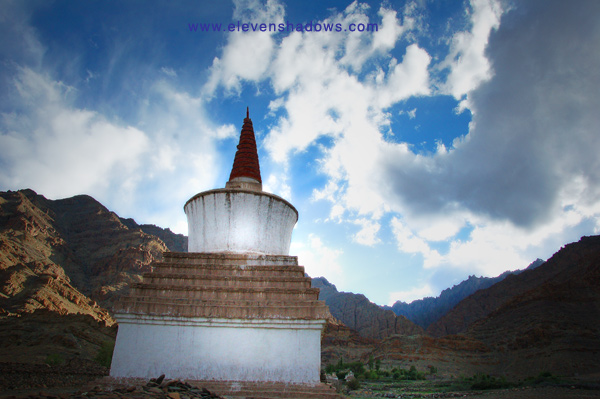 One
of the stupas as one climbs up the valley to Hemis Monastery. Although
driving this time, little did I know that I would get to know much of this
valley and its mani stones quite well when I returned for the Hemis
Festival. One
of the stupas as one climbs up the valley to Hemis Monastery. Although
driving this time, little did I know that I would get to know much of this
valley and its mani stones quite well when I returned for the Hemis
Festival. |
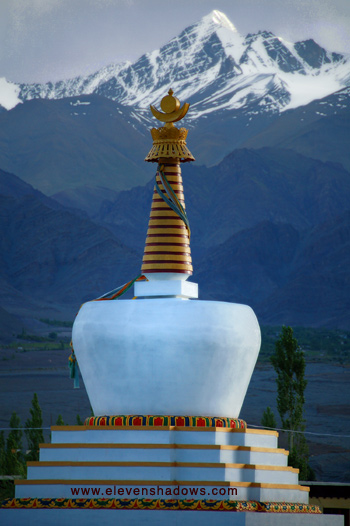 We
returned on the Manali road, following it back up the Indus Valley.
Along the way, we stopped to view some of the stupas in Choglamsar, just
fifteen minutes from Leh, with the mighty Himalayan peaks in the distance. We
returned on the Manali road, following it back up the Indus Valley.
Along the way, we stopped to view some of the stupas in Choglamsar, just
fifteen minutes from Leh, with the mighty Himalayan peaks in the distance. |
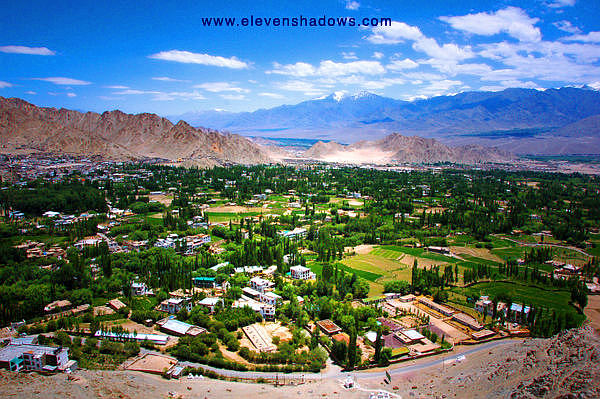 1
July - The
next day, Tom and I still felt a bit odd. 12-hour
jet lag, 3500 meter (11,500 ft) altitude, and adjusting to new food can do
that to you. And unfortunately, Tom was feeling it. I felt okay,
and walked through the quiet main street of Changspa and up the steep steps
to Shanti Stupa. Tom, not feeling well, turned back and headed back down
towards Mentonkling Cafe, where he shouted out to me later as I passed by. 1
July - The
next day, Tom and I still felt a bit odd. 12-hour
jet lag, 3500 meter (11,500 ft) altitude, and adjusting to new food can do
that to you. And unfortunately, Tom was feeling it. I felt okay,
and walked through the quiet main street of Changspa and up the steep steps
to Shanti Stupa. Tom, not feeling well, turned back and headed back down
towards Mentonkling Cafe, where he shouted out to me later as I passed by.This is the view of Leh, with Changspa in the front, while climbing the steps towards Shanti Stupa. |
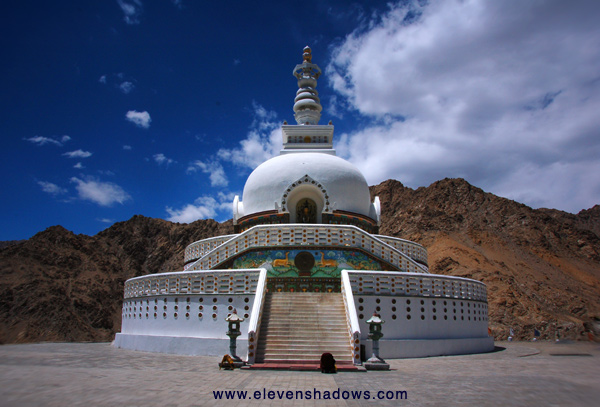 Shanti
Stupa is not exactly an ancient edifice. Shanti
Stupa is not exactly an ancient edifice.A Japanese guy living in India wanted to spread Buddhism and decided to build it. Financed by the Japanese government and other entities, he realized his dream in 1985, way back when Michael Jackson ruled the airwaves. Now, I can't help but think that if one is spreading Buddhism, building it in a place where there are literally hundreds of thousands of chortens and stupas in a predominantly Tibetan Buddhist region is preaching to the, uh, tantric choir. |
The Himalayas of India: Ladakh and Dharamsala, Summer 2008
Page 2 of 16
1 2 3 4 5 6 7 8 9 10 11 12 13 14 15 16
Eleven Shadows Travel Page
Contact photographer/musician Ken Lee